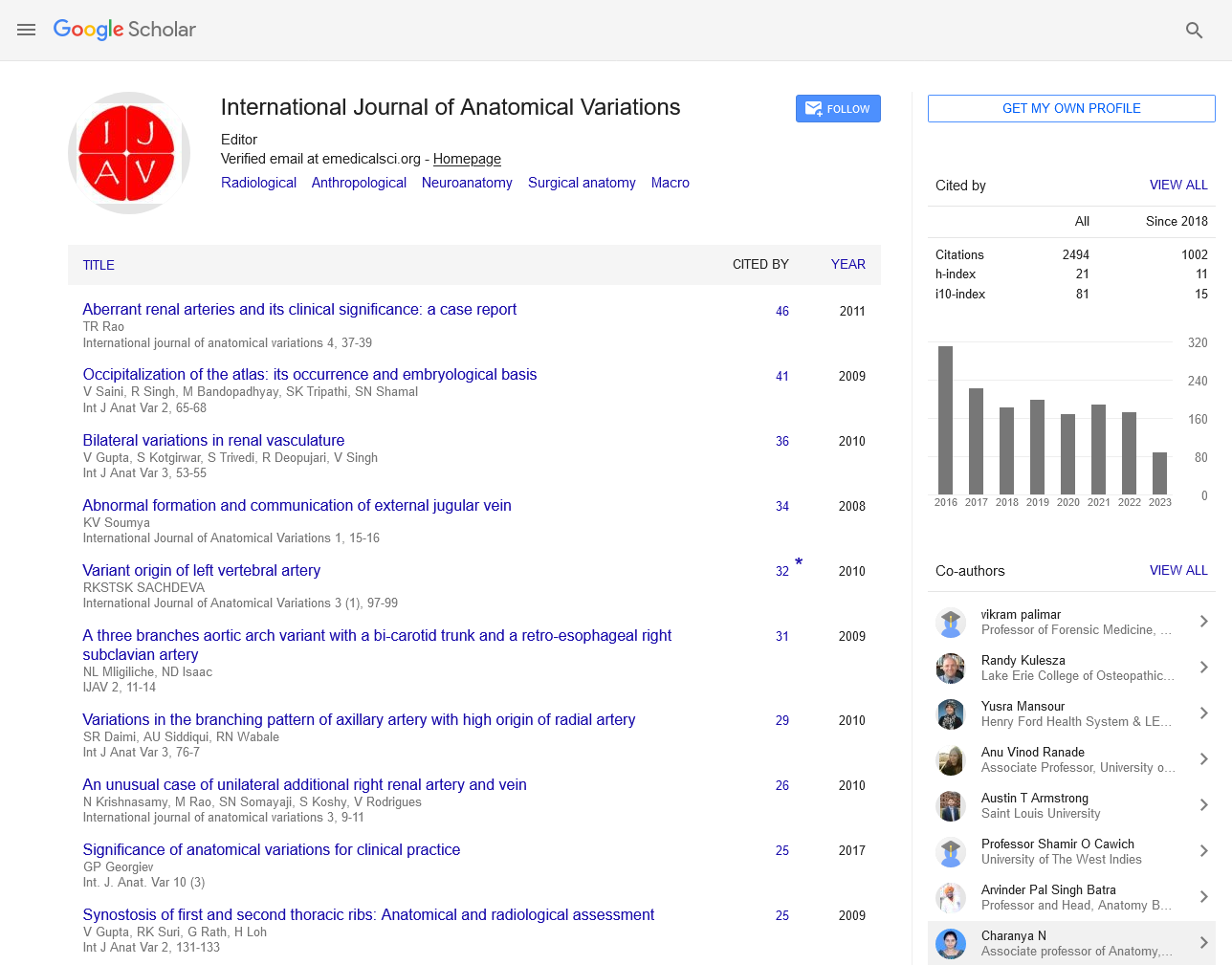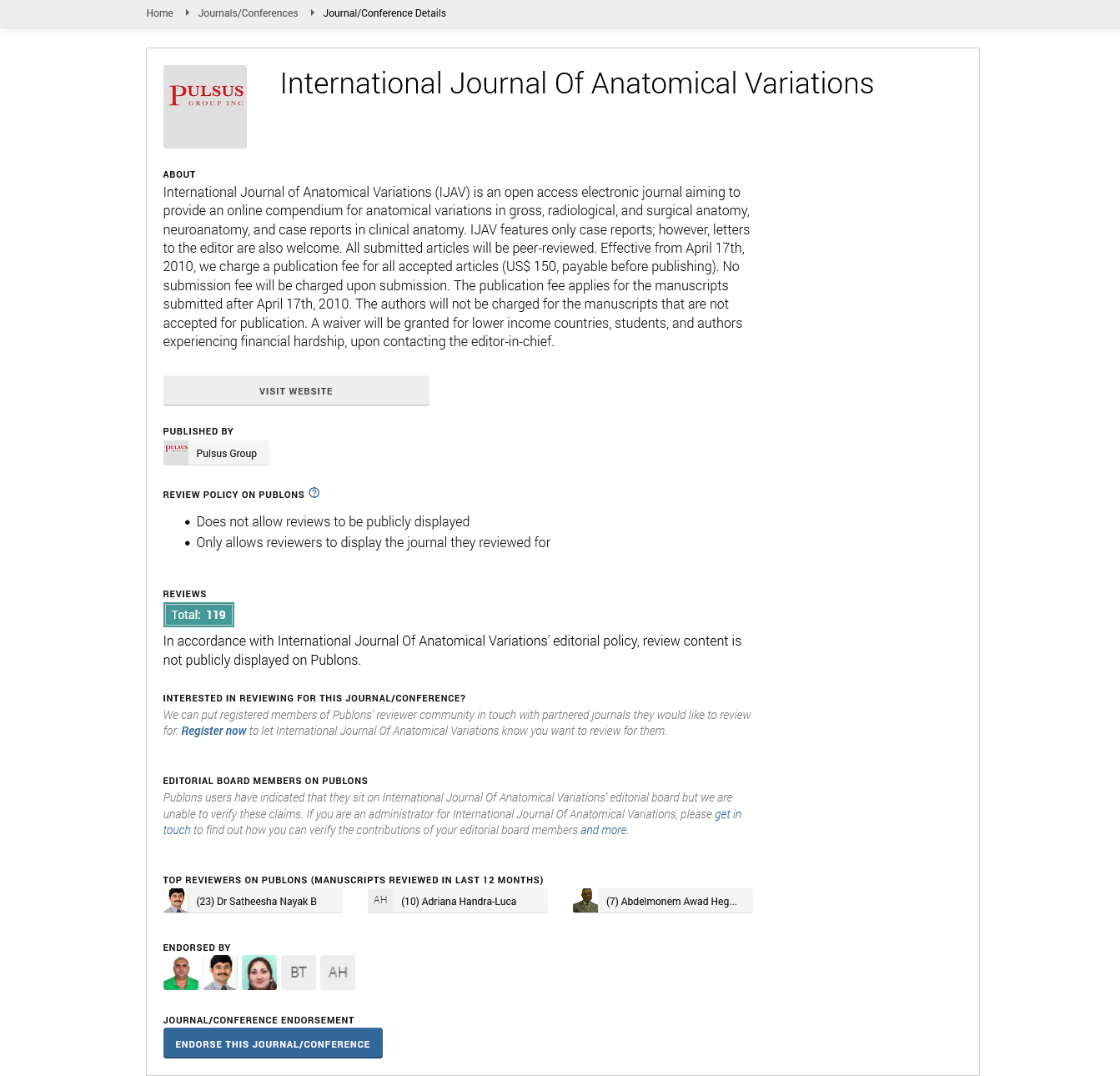The Autonomic Nervous System Structure Function and Clinical Implications
Received: 01-Apr-2025, Manuscript No. ijav-25-7672; Editor assigned: 04-Apr-2025, Pre QC No. ijav-25-7672 (PQ); Reviewed: 21-Apr-2025 QC No. ijav-25-7672; Revised: 26-Apr-2025, Manuscript No. ijav-25-7672 (R); Published: 30-Apr-2025, DOI: 10.37532/13084038.18(4).506
Citation: Singh A. The Autonomic Nervous System Structure Function and Clinical Implications. Int J Anat Var. 2025; 18(4): 780-780.
This open-access article is distributed under the terms of the Creative Commons Attribution Non-Commercial License (CC BY-NC) (http://creativecommons.org/licenses/by-nc/4.0/), which permits reuse, distribution and reproduction of the article, provided that the original work is properly cited and the reuse is restricted to noncommercial purposes. For commercial reuse, contact reprints@pulsus.com
Abstract
The autonomic nervous system (ANS) is a vital component of the peripheral nervous system that regulates involuntary physiological processes, including heart rate, blood pressure, respiration, digestion, and sexual arousal. The ANS is traditionally divided into the sympathetic and parasympathetic divisions, with a complementary role from the enteric nervous system. This article provides a comprehensive review of the anatomical structure, functional roles, neurochemical mediators, and clinical relevance of the ANS. Emerging insights into its plasticity and interactions with the immune system and microbiome highlight the evolving understanding of autonomic regulation. Additionally, the article explores disorders associated with autonomic dysfunction and discusses current therapeutic approaches.
INTRODUCTION
The autonomic nervous system (ANS) is essential for maintaining homeostasis and adapting bodily functions in response to environmental changes [1]. Unlike the somatic nervous system, the ANS operates largely below the level of consciousness and modulates visceral functions. Understanding the ANS is crucial for clinicians and researchers, as its dysfunction is implicated in a variety of conditions, from cardiovascular diseases to anxiety disorders [2].
ANATOMICAL AND FUNCTIONAL ORGANIZATION
Originating from the thoracolumbar spinal cord (T1–L2), the sympathetic division is often associated with the “fight or flight” response. Preganglionic neurons release acetylcholine, which binds to nicotinic receptors in the sympathetic ganglia [3]. Postganglionic neurons predominantly release norepinephrine, targeting adrenergic receptors on effector organs. The parasympathetic division originates from the brainstem (cranial nerves III, VII, IX, and X) and sacral spinal cord (S2–S4). It promotes the “rest and digest” functions. Preganglionic fibers are long and synapse near or within target organs, releasing acetylcholine that binds to muscarinic receptors. Often referred to as the “second brain,” the enteric nervous system (ENS) operates semi-autonomously to control gastrointestinal motility and secretion. It communicates with both sympathetic and parasympathetic systems and consists of two main plexuses: the myenteric and submucosal plexuses [4].
NEUROTRANSMITTERS AND RECEPTORS
The ANS utilizes various neurotransmitters including acetylcholine, norepinephrine, dopamine, and neuropeptides. Receptors are classified as cholinergic (nicotinic, muscarinic) and adrenergic (alpha, beta). The distribution and subtype expression of these receptors dictate tissue-specific responses.
CENTRAL REGULATION OF AUTONOMIC FUNCTION
The hypothalamus, brainstem (medulla oblongata, pons), and spinal cord play pivotal roles in integrating autonomic inputs and outputs. The nucleus tractus solitarius and the rostral ventrolateral medulla are key regions for cardiovascular and respiratory control [5].
CLINICAL IMPLICATIONS AND DISORDERS
Dysautonomia encompasses a range of conditions such as postural orthostatic tachycardia syndrome (POTS), multiple system atrophy, and pure autonomic failure. Symptoms include orthostatic hypotension, gastrointestinal dysmotility, and thermoregulatory disturbances. Hyperactivity of the sympathetic system is linked to hypertension and heart failure. Autonomic imbalance is a predictor of sudden cardiac death and adverse outcomes in myocardial infarction. The ANS is intricately linked to emotional processing. Dysregulation is observed in anxiety, depression, and PTSD, often characterized by increased sympathetic tone and decreased heart rate variability.
DIAGNOSTIC AND THERAPEUTIC APPROACHES
Autonomic function tests include tilt table testing, heart rate variability analysis, and quantitative sudomotor axon reflex testing. These help assess sympathetic and parasympathetic balance. Pharmacological treatments include beta-blockers, fludrocortisone, midodrine, and anticholinergics, tailored to the specific autonomic condition. Non-pharmacological strategies include hydration, compression garments, and biofeedback. Vagus nerve stimulation, neuromodulation, and microbiome-targeted interventions are under investigation for their potential to modulate autonomic output and treat dysautonomia.
DISCUSSION
Advances in neuroscience have reshaped the understanding of the ANS from a rigid binary system to a dynamic, integrated network influenced by genetics, environment, and disease states. The interface between the ANS, immune system, and gut-brain axis offers novel insights into chronic inflammatory and neurodegenerative diseases.
REFERENCES
- Mamikonyan VR, Pivin EA, Krakhmaleva DA. Mechanisms of corneal neovascularization and modern options for its suppression. Vestn Oftalmo. 2016; 132(4):81-87.
- Jun S, Zhang-Y, Chuan C. Postoperative neovascularization, cerebral hemodynamics, and clinical prognosis between combined and indirect bypass revascularization procedures in hemorrhagic moyamoya disease. Clin Neurol Neurosurg. 2021 Sep; 208:106869.
- Xin W, Bofu L. Aortic Dissection with Rare Anatomical Aortic Arch Variation Depicted by Computed Tomography Angiography. Heart Surg Forum. 2021; 24(2): E407-E408.
- Foivos I, Jonathon K, Daryll B. Aberrant right subclavian artery - a rare congenital anatomical variation causing dysphagia lusoria. Vasa. 2021; 504(5):394-397.
- Schizas N, Patris V, Lama N. Arc of Buhler: A lifesaving anatomic variation. A case report. J Vasc Bras. 2012; 37(11):9-326.
Indexed at, Google Scholar, Crossref
Indexed at, Google Scholar, Crossref
Indexed at, Google Scholar, Crossref
Indexed at, Google Scholar, Crossref






